You want four hand-painted, scenic panels 13 in. wide and 186 in. tall?
By Al R. Young
The commission to create a scenic tetraptych painting for four pilasters as part of the Stein Eriksen Lodge Deer Valley conference center renovation project presented a most interesting compositional challenge. This polyptych painting was to consist of scenic images measuring 13.5 in. wide x 186.5 in. high. The only other requirement was that the subject be suitable to the halcyon alpine setting of the lodge itself.
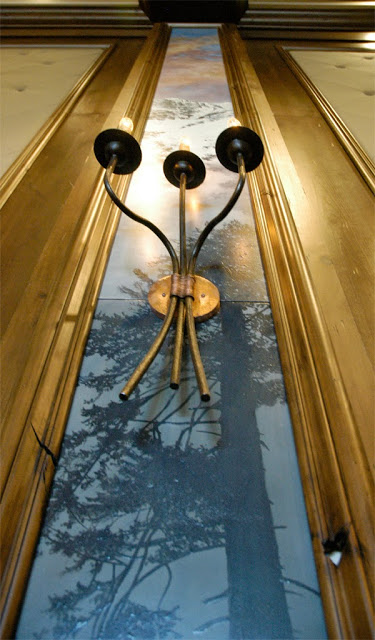 |
| The painting consisted of four images of this size, three installed on pilasters at the front of the conference center and one installed on a pilaster at the back of the room. |
Four images, each measuring 13.5 in. x 186.5 in. (10,071 square inches or 69.9 square feet)
Support
Panel
Milestones
Research begins - November 2012
Composition begins - April 2013
Brush work begins - April 2013
Equipment
Creating a painting often involves creating or modifying tools or making improvements to the studio itself.
Building the studio's loft easel expressly for this artwork
See also Producing 250 square feet of hand-painted panels, which briefly describes the studio-defined process for preparing the panels and presents links to equipment created for the project.
Methodology
Drawing upon the research and conceptualization done for the two other landscape-painting commissions involved in this project (Den Kommende Våren and Den Kommende Vinteren), I decided to treat each image as though it were a window onto nearby mountains. Thus, the images of the tetraptych do not assemble into a single, seamless painting, but cohere in the manner of windows facing different compass points while opening upon the same vista.
Other compositional factors included:
A wall sconce to be mounted 58.75 in. above the bottom of the image area on the pilaster
The maximum length of hardboard available for the support was 8 ft.
Viewers would be able to get right up against the bottom part of each image
Panel-seams in the image would be unavoidable. Optimally, any seams would be as far above the viewers' heads as possible, but with a wall sconce to be installed about five and a half feet from the floor, putting a seam at the sconce would simplify the cutting of holes in the panels for installation of the fixtures, and reduce the possibility of image damage in the process. That meant that the bottom panel would be 58.75 in. high. The panel above it would be the 8 ft. panel, and the upper panel would be 31.75 in.
In view of these constraints, I decided to offset the image content from the panel seams as indicated in the following sketch. Clear sky and clouds would therefore occupy the whole of the top panel and end somewhere just below the top of the middle panel. The snowfields and rocks of the summits would then occupy most of the middle panel, fading into valley fog and then the silhouette of foreground trees. Just below the treetop silhouettes, at the bottom of the middle panel, the image would cross the seam at the wall sconce and continue in silhouette to the foreground at the base of the bottom panel.
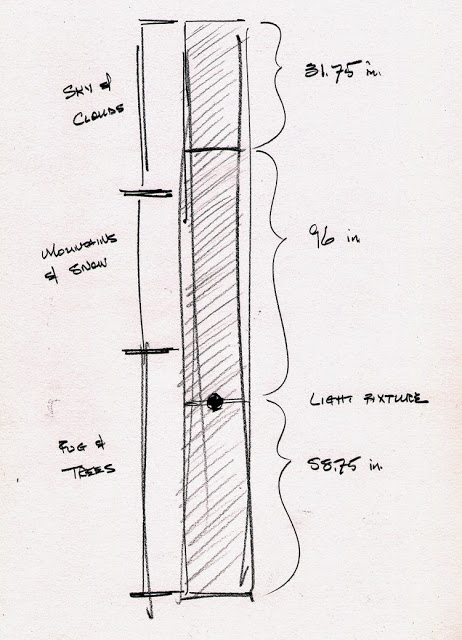 |
| Al's sketch setting forth the manner in which the image content of each panel in the painting was reconciled with design constraints listed above. |
Painting such severely vertical landscape slices was daunting even though I find myself almost invariably drawn to vertical compositions regardless of the subject. I could not help but think of drawings like those shown below, which, though done in miniature, constitute much the same approach to the subject. Each leaves the space beyond the edges of the image to be composed or (in the case of the tetraptych) connected to adjacent images. While most approaches to landscape provide a vista, these vertical compositions are focal points.
Landscape paintings are usually horizontal, perhaps because land and the horizon are fundamentally horizontal. Vistas are usually horizontal; expansive in every direction, to be sure, but perhaps predominantly horizontally. Nevertheless, I like to look up. I like things that invite an upward glance, an upward thought, an upward reach, particularly when life itself narrows because of affliction. I like high ceilings and tall windows, not just in terms of the built environment, but in music and stories, in humor, in kindness, in conduct, in everything.
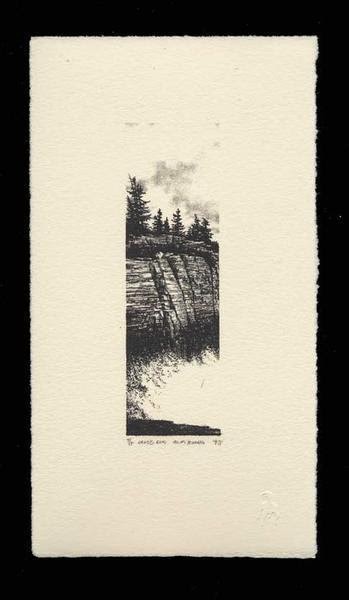 |
| Land's End by Al R. Young |
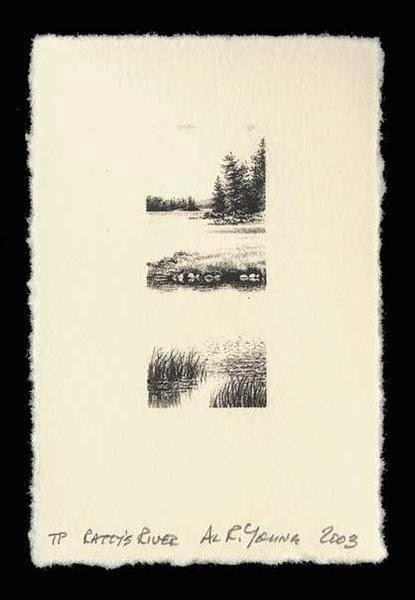 |
| Ratty's River by Al R. Young |
Ashton took care of preparing the supports, which, of course, consisted of 16 pieces of Masonite. After being cut to specifications, the panels were prepared in the same manner as the ornamental panels.
With sixteen pieces involved, a unique label on the back of each panel was important from the outset in keeping track of which panel was part of which image.
Brush work
I started with the sky for each image and painted my way down the panels, completing a classical grisaille for the upper third of the image, then the mountains and snowfields, then the fog, etc. The following photo was taken on the first day of brush work on the painting, and shows the top panel clamped onto the easel with the middle panel of the image immediately below. This was the arrangement I wanted at each seam so that brush strokes in the creation of the image might easily flow across the seams. When I paint a sky, I do so with considerable energy. Having to halt at a seam and resume on another panel would have hindered the flow of ideas.
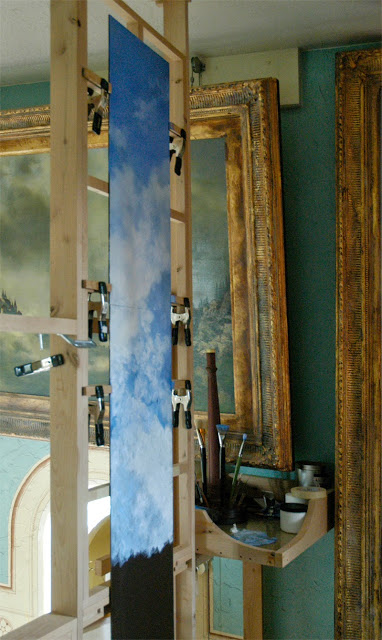 |
| The top and middle panels are clamped together on the loft easel for the initial application of sky and clouds. The piano leg brush holder sets on the palette shelf of the loft easel, where a .25-in. piece of glass rests as a palette. |
White was the only color I applied in painting the grisaille of the mountains. The color of the stone results from scraping white over the dark color of the under-layer. The fog, however, was a mixed color applied by brush.
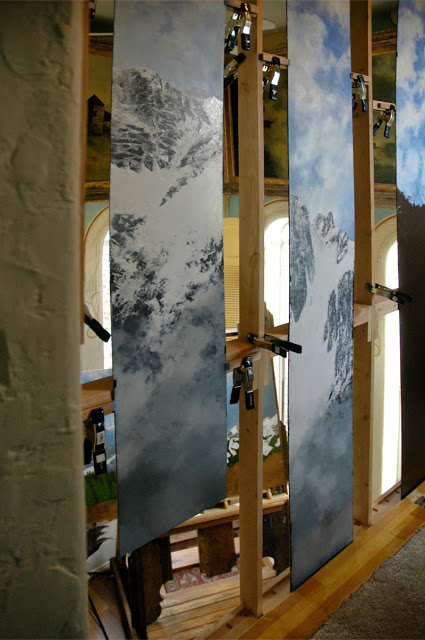 |
| As the painting of the panels got into full swing, the loft easel also served as the drying rack for the unwieldy pieces of Masonite. |
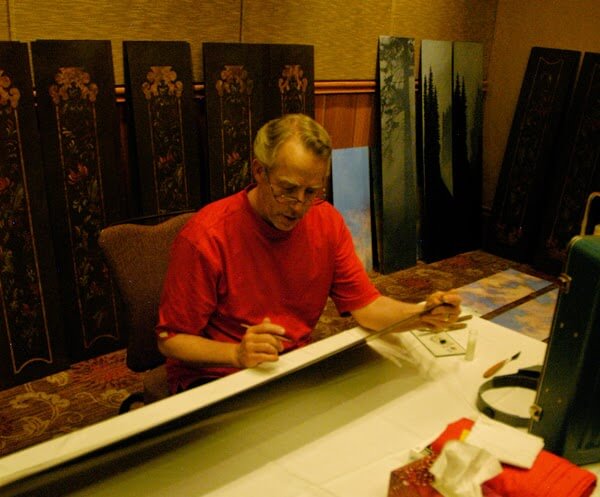 |
| Minor damage to a couple of the panels during shipment required an on-site visit to make repairs prior to panel installation. The traveling palette kit plays a key role in such visits.
Visit us on Pinterest to see more photos of this and other stages of the Stein Eriksen Lodge Deer Valley conference center project. |
Tags: 2013, Project commentaries
Browse articles by year: 2025 . 2024 . 2023 . 2022 . 2021 . 2020 . 2019 . 2018 . 2017 . 2016 . 2015 . 2014 . 2013 . 2012 . 2011 . 2010 . 2009 . 2008 . 2007 . 2006 . 2005 . 2004 . 2003 . 2002 . 2001 . 2000 . 1999 . 1998 . 1997 . 1996
Browse articles by topic: Art lessons . BenHaven Archives . Blank art diaries . Fine art photography . Framing . Illustration . Inspiration and creativity . Isles of Rune . Limited Editions Collection . My Fathers Captivity . News . Novellas . Oil paintings and prints . Operations announcements . Orders and shipping . Overview . Portfolios . The Papers of Seymore Wainscott . Project commentaries . Recipes by Nancy Young . Recommended reading . Recommended viewing . Temple artworks . The Storybook Home Journal . Tips and techniques . Tools supplies and operations
Browse articles by topic: Art lessons . BenHaven Archives . Blank art diaries . Fine art photography . Framing . Illustration . Inspiration and creativity . Isles of Rune . Limited Editions Collection . My Fathers Captivity . News . Novellas . Oil paintings and prints . Operations announcements . Orders and shipping . Overview . Portfolios . The Papers of Seymore Wainscott . Project commentaries . Recipes by Nancy Young . Recommended reading . Recommended viewing . Temple artworks . The Storybook Home Journal . Tips and techniques . Tools supplies and operations